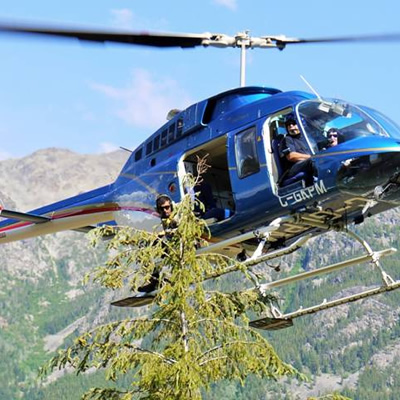Tree-top sampling program may help uncover new mineral deposits in B.C.

Helicopter-supported treetop sampling is an effective way of quickly acquiring samples over large inaccessible areas of British Columbia. — Photo cour
Helicopter-supported treetop sampling is an effective way of quickly acquiring samples over large inaccessible areas of British Columbia. — Photo courtesy Geoscience BC
British Columbia’s trees may hold the key to finding new mineral deposits in the province.
Geoscience BC is releasing the results of an innovative tree-top sampling program led by Noble Exploration Services Ltd. The study looked at whether trace amounts of metals found in spruce trees could lead prospectors to the next big mineral discovery. As part of the TREK project, (Targeting Resources through Exploration and Knowledge), a total of 421 side-branch samples, comprising one kilogram of twigs and needles, were systematically collected near the tops of healthy, 80- to 100-year-old spruce trees over a six-day period in June 2015. Samples were collected using a helicopter flying over a 1,000-square-kilometre area in the Chilcotin Plateau of central British Columbia.
“It’s well established that coniferous trees such as spruce can pick up metals and other elements from the soil and concentrate them in the bark, twigs and needles,” said Bruce Madu, vice-president, Minerals and Mining, Geoscience BC. “Through this program, we hope to provide new information that will encourage people to take a fresh look at the area’s mineral potential.”
Results of the tree-top sampling program were discussed at the 29th Annual Kamloops Exploration Group (KEG) Conference at the Coast Kamloops Hotel and Convention Centre in Kamloops, B.C.
Helicopter supported tree-top sampling can be an effective way of quickly acquiring samples over large inaccessible areas, and was particularly well suited to the Chilcotin Plateau. The area is relatively flat, has a variety of overburden materials, few lakes and limited road access that restricts traditional sampling options. This area is also located approximately 15 kilometres south of the Blackwater Gold project, site of a proposed open pit gold and silver mine with proven and probable reserves of 8.2 million ounces of gold and 60.8 million ounces of silver.
“The regional scale of this tree-top sampling program is a new venture for Geoscience BC,” added Robin Archdekin, president and CEO, Geoscience BC. “It’s a pilot program designed to evaluate the effectiveness of this technique over a much larger area than previous projects.”
Over the last three years, Geoscience BC’s $4 million multidisciplinary TREK project is providing a better understanding of the geology and mineral potential of a 24,000-square-kilometre area that extends south from Vanderhoof and Fraser Lake and west from Quesnel.
To view video footage of how the helicopter-supported, spruce-top twig-and-needle survey was conducted, please click here.
The summary report, digital data and survey maps are available at Geoscience BC Report 2016-05: Reconnaissance Biogeochemical Survey using Spruce-Tops in the West Road (Blackwater) River Area or click here to explore the data in the Earth Science Viewer.
Created in 2005, Geoscience BC is an independent, credible source of earth science information to attract investment and enable responsible resource decisions for the benefit of all British Columbians. Visit www.geosciencebc.com.



